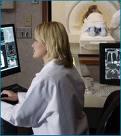
April 23, 2009 - A new federally funded University of Pennsylvania School of Medicine study aims to learn whether women at high risk of breast cancer can use exercise to meaningfully reduce their risk of getting the disease. Building on evidence that reducing estrogen in the body reduces cancer risk, and that elite female athletes experience a drop in estrogen levels that often cause them to stop ovulating and menstruating, the WISER Sister trial will investigate two different levels of regular treadmill exercise as a possible intervention for breast cancer risk reduction. The stakes for women who carry BRCA genetic mutations are high - as many as 80 percent of them will develop breast or ovarian cancer during their lives - but options for risk reduction are drastic and few, and the choices may be unacceptable to some women. Previous Penn research shows that prophylactic mastectomy slashes carriers' breast cancer risk by 90 percent, while prophylactic oophorectomy, or ovary removal, halves their breast cancer risk and reduces their chances of getting of ovarian cancer by about 85 to 90 percent. Though the surgeries are highly effective, they usher in quality of life concerns - particularly with regard to body image and sexuality - and the early menopause that results from ovary removal brings a woman's childbearing years to an end. And the procedures aren't recommended for women who have a family history of breast cancer but don't carry the mutated genes. "The decision to have these surgeries is so difficult that many women delay them, sometimes with terrible consequences. We would like to find out if exercise could buy high-risk women time they need to more safely think through their options," said Kathryn Schmitz, PhD, MPH, an assistant professor in the Center for Clinical Epidemiology and Biostatistics who is leading the new study, in partnership with Susan Domchek, M.D., director of the Abramson Cancer Center's Cancer Risk Evaluation Program. "Exercise also has a number of health and stress reduction benefits that make it even more attractive for this population." Over the next three years, Schmitz's team will enroll 160 women ages 18 to 40, who must have an elevated risk of getting breast cancer based on her family history of the disease. BRCA carriers will be included among eligible women. However, participants will not be required to undergo genetic testing. Previous research on estrogen exposure strongly suggests that reducing estrogens will result in reduced breast cancer risk in this population. The investigators plan to use their findings to offer effective exercise guidelines for high-risk women. Unlike surgery, exercise is a low-cost intervention with few side effects, so Schmitz is hopeful that the study results will offer risk-reduction tools to a larger swath of high-risk women, including minorities and other groups that may be underserved or lack access to genetic testing or proper early screening. "We are interested in rigorously investigating all potential options to decrease cancer risk," says Domchek, an associate professor of Medicine in the division of Hematology/Oncology. "Exercise is a wonderful intervention due to its numerous health benefits. However, it is important for us to quantify the amount of exercise needed and the potential benefits such exercise might provide." Although it is unknown how much the exercise interventions tested in the trial will reduce estrogen exposure, Schmitz says even evidence of marginal risk reduction -- that exercise may help delay breast cancer onset, decrease breast density to improve the accuracy of early screening tests, or result in smaller tumors -- could be of help to women planning risk reduction strategies during their 20s and 30s. Trial participants will be placed into three randomized groups who will be followed for seven months. Each participant will receive a treadmill to use at home, which she will get to keep after the study is over. A "low dose" group will complete 150 minutes of exercise each week, the same amount recommended for general health and fitness, while a "high dose" group will do 300 minutes of exercise each week, similar to the workouts recommended for weight control. A third group, serving as the control, will continue doing their usual activities for the duration of the study and will receive the treadmill at the end of study completion. Each woman will give daily urine samples at points during the trial, which will allow investigators to measure their levels of estrogen, progesterone and other sex hormones. The women's body composition will also be measured, and they will receive breast MRIs at no cost to them before and after the study to examine changes in the density of their breast tissue. "It is frightening to face high risk for breast cancer at a young age. Most of us think of cancer as something that happens later in life. Young women may not even want to approach the issue of getting genetic testing yet, but may want to do something. The WISER Sister study offers those women an option," Schmitz says. "The benefits of the study will have a ripple effect to other good health habits, too, by helping women adopt a regular exercise regimen." The WISER (Women in Steady Exercise Research) Sister trial is funded by a grant from the National Cancer Institute, which is part of the U.S National Institutes of Health. For more information: bmic.upenn.edu/wiser


 March 21, 2025
March 21, 2025 








